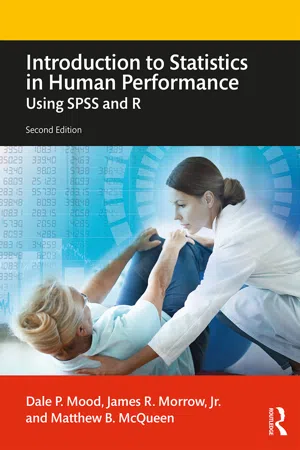INTRODUCTION
For the human performance professional, statistical analyses and research studies play a useful and important role in everyday life. To see this, consider the physical therapist who works with a wide variety of patients, such as knee replacement recipients, stroke patients, patients with arm or shoulder injuries, patients with severe burns, and so forth. The therapist is interested in treating each patient with the modality that has been shown to be most effective for each individual’s specific injury, surgery, or condition. Physical therapists review the scientific literature and make decisions regarding the best practice to help return each patient to full function as quickly and efficiently as possible. The effectiveness of the various modalities is determined through research studies that adhere to the scientific process. For another example, think about a coach who has to decide which potential players to keep on the team and which to cut. In this decision process, what are the most important physical characteristics, skills, and abilities that the coach should consider? What psychological attributes are important, what leadership and motivational traits are crucial, and how can all of these characteristics, traits, and attributes be measured accurately? The coach who knows how to read the scientific literature critically and who can learn through experimentation will make sound decisions based on the available evidence. Professionals need to make evidence-based decisions, whether they be in a clinical, academic, athletic, or performance setting. Thus, we hope that you will become excited about conducting research, gathering data, and making decisions that are based on data. Such decisions will positively influence your clients, students, colleagues, and, ultimately, the world of human performance.
V.1.1
Introduction to Research Issues and VocabularyIt is not unusual in human performance curricula to devote an entire semester to the study of research methods. The research methods course often covers topics such as defining the research question, reviewing the literature, describing the methods used, analyzing and interpreting the results, writing the conclusions, and disseminating the findings. Because this text is essentially about statistics, we will not discuss all of these topics, but, rather, we will focus on those aspects of the research process that directly relate to statistical procedures and decisions. Thus, as we build a foundation for learning how to use statistical procedures when making scientific decisions, we will introduce and distinguish between research and statistics terminology.
In some cases, the design of a research project will dictate what statistical procedures are appropriate; in other situations, the statistical procedures that may be used will necessitate the adoption of certain aspects of the research design. For an example of the first situation, if the variable of interest can be measured only in a categorical or ranking manner, then the use of a nonparametric statistical procedure (see Chapter 14) is called for. The second situation might occur when the assumptions required for a particular statistical procedure dictate how subjects will be grouped or the number of subjects necessary in each possible combination of treatments.
Therefore, to select efficient statistical procedures, some knowledge of research methods is required, and to select the best research design, knowledge of statistics is necessary. Thus, in this chapter we discuss the elements of research methods that affect the selection of appropriate statistical procedures.
THE NATURE OF RESEARCH
How do people “know” things? There are several ways. For one, individuals or groups have experiences, and through these experiences we learn about phenomena. Experiences might include personal observations or input from other people, and they might be rational in nature or, perhaps, influenced by superstitions. Experiences are limited, and they are sometimes misleading. Imagine that you have observed that every time you eat a particular meal before a sporting event, you perform well. That may or may not be a true relationship (that is, you might have made inaccurate observations or have come to an unjustified conclusion), and, if it is a true relationship, the relationship may or may not be causal. That is, the fact that two things tend to happen at the same time does not in itself necessitate that one causes the other.
Because of these limitations of learning through experience, humans have developed the research process as the preferred way of learning. The research process is organized, logical, and scientific. The results of sound research processes are reproducible and generalizable (that is, the findings and conclusions from a research study conducted on a sample of subjects can be extended, or generalized, to the population from which the subjects were selected). One element of the research process is the scientific method, which helps researchers learn about the relationship between a treatment (or an exposure) and the impact of that treatment on measured outcomes. A treatment is something that subjects are required to do (such as take a particular medication), and exposure refers to a condition or behavior in which a subject engages (such as a sedentary lifestyle). For example, one relationship that a researcher might explore is that between a sedentary lifestyle and negative health consequences, and whether this relationship is the same for both males and females. The research process helps scientists make decisions about relationships like this one. The research process is not infallible. Quite the opposite: much of the research process is based on probability, and drawing incorrect conclusions is always a possibility.
GAINING KNOWLEDGE
Theories
A theory is an educated supposition about a relationship among some natural phenomena. Generally, theories are derived through observation, experimentation, and reflective thinking. For example, Henry and Rogers (1960) proposed the memory drum theory, which has to do with how humans learn and execute motor skills. According to Henry’s theory, unconscious neural patterns acquired from past experiences are stored in the central nervous system as a “memory storage drum”. A competing theory, called schema theory, was advanced by Richard Schmidt (1975). Schema theory suggests that, instead of storing a memory for every previous movement, we store previously obtained information about the relationships involving joint actions and muscular contractions to produce a movement to be used to adapt to new situations. Additional theories have since been postulated by other researchers in the field of motor behavior, but the purpose here is not to debate which theory is correct. Rather, the purpose is to indicate that a theory is not a proven fact; instead, it is someone’s supposition about the relationships among variables and the expectations that flow from such a supposition. When scientists conduct experiments, often the goal is to provide evidence to support or to refute a particular theory.
Hypotheses
A hypothesis is a prediction derived from a theory or a researcher’s speculation regarding the likely outcome of an experiment. A research hypothesis might take a form like the following: “If subjects are exposed to a certain treatment, then there will be a measurable change in a particular variable”. A research hypothesis might state that greater changes would be expected from exposure to treatment A than from exposure to treatment B—a supposition that, again, is based on measurement of an outcome variable. For example, an exercise scientist might hypothesize that two different strength-training regimens result in dissimilar modifications of muscle fiber characteristics.
The treatment that is manipulated by the researcher is known as the independent variable. The variable that is expected to change (the outcome) is called the dependent variable. Thus, the research hypothesis predicts the expected relationship between the independent variable and the dependent variable. Let’s consider another example, this one based on current thinking regarding the relationship between physical activity and body weight. A general research hypothesis might state that “increases in physical activity are associated with decreases (or maintenance) of body weight”. A specific research study could be conducted to examine this hypothesis. Depending on the researcher’s interests, subjects could be assigned to one of several possible levels of the independent variable (physical activity), such as sedentary, light, moderate, and vigorous. After subjects’ exposure to these treatments, the researcher can determine whether meaningful differences occurred among the average body weight (dependent variable) of the groups. This result would support or refute the hypothesis. Notice we did not say this result would prove or disprove the hypothesis.
In contrast to a research hypothesis, a null hypothesis states that the independent variable and the dependent variable are not related. That is, exposure to a particular treatment will not result in any predictable change in the dependent variable.
Inferential statistical tests are designed to examine the viability of the null hypothesis, not the research hypothesis. As will be explained in detail in later chapters, statistical tests examine the relationship between the independent and dependent variables. The relationship might take the form of differences among measurements or a correlation between the independent and dependent variables. The researcher tests the likelihood of obtaining such a difference or relation, assuming the null hypothesis is actually true. If the probability of obtaining such a relation or difference is found to be very unlikely, the researcher will reject the null hypothesis and accept the research hypothesis (sometimes called the alternative hypothesis). In some cases, the null hypothesis might be the research hypothesis. For example, if two physical therapy modalities (one expensive and the other inexpensive) are available for treating a particular malady, a researcher might hope that the null hypothesis is tenable.
V.1.2
How Statistics Fit into ResearchThese methods and interpretations are important to understanding hypothesis testing and much of the scientific literature. They provide the keys and logic that will help you comprehend all inferential statistical testing, as well as the many very advanced statistical explanations that research consumers (i.e., human performance professionals) encounter on a daily basis.
LEVELS OF KNOWLEDGE
The word science is derived from the Latin word scientia, meaning “having knowledge”. There are several hierarchical levels of scientific knowledge. The lowest level is description; then we move to prediction, then to control, and finally to explanation. Because cardiovascular disease is a serious illness in our society today, we will use it to illustrate these levels of knowledge.
Description Level of Knowledge
Heart disease, although decreasing in prevalence in recent years, still accounts for nearly a quarter of the annual deaths in the United States in both males and females. Several agencies (e.g., Centers for Disease Control and Prevention, American Heart Association) collect descriptive data on causes of death and compile the information according to many different categories (e.g., gender, age, ethnicity). Th...



